Non-movie superheroes. Who and how protects the Lakhta Center construction site from fires?

Do you think the photo on fire or not? In this post we tell - after all, was there ever a fire in the Lakhta Center or was it not? And also - why is the danger of a fire at a construction site higher than in a finished building? How to deal with it? Finally, why did we deceive you when we said that the core was the first to gain height in the Lakhta Center tower, and that it was actually being built ahead of the skyscraper.
WHY FIRE FIGHTERS DO NOT LIKE BUILDINGS
Everyone knows that firefighters do not like skyscrapers. More skyscrapers firefighters do not like only their construction sites. The construction of a high-rise building is always a risk zone.

Thousands of people work here, hundreds of technological operations are carried out at the same time, including such "bad" ones as welding or laying electrical networks, and non-standard heating and heating appliances are also used. It’s crowded at the sites - sophisticated equipment maneuvers, materials are stored, temporary construction camps are being built ...
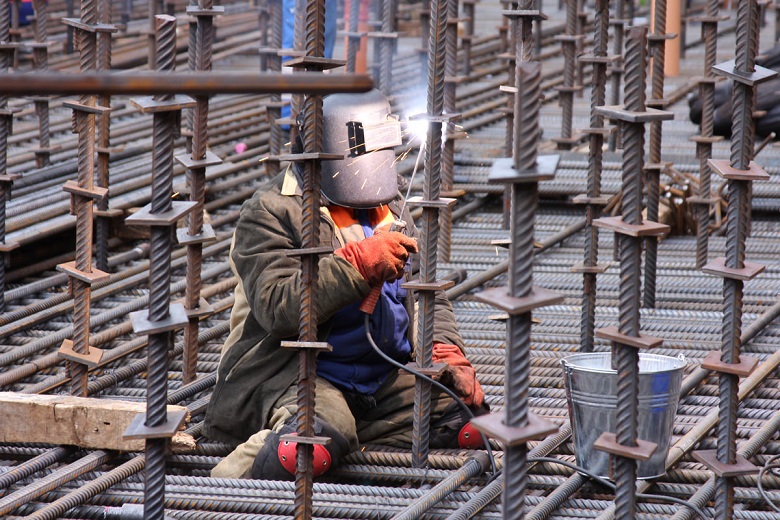
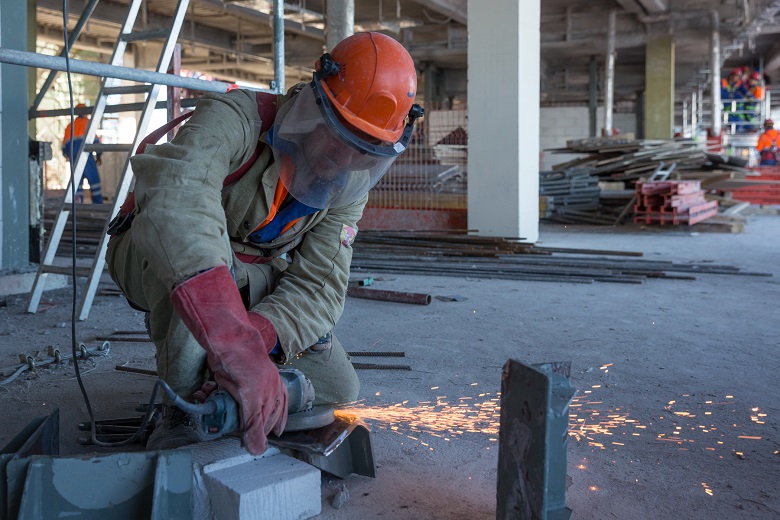
Fire and welding work at the Lakhta Center construction site, archive
Worst of all, the building landscape is constantly changing: the building is growing and there simply cannot be an unchanged plan of action - you need to constantly study the situation. What about fire systems? After all, they are still not at all the same as in the finished object. The feelings of the fire service are understandable.
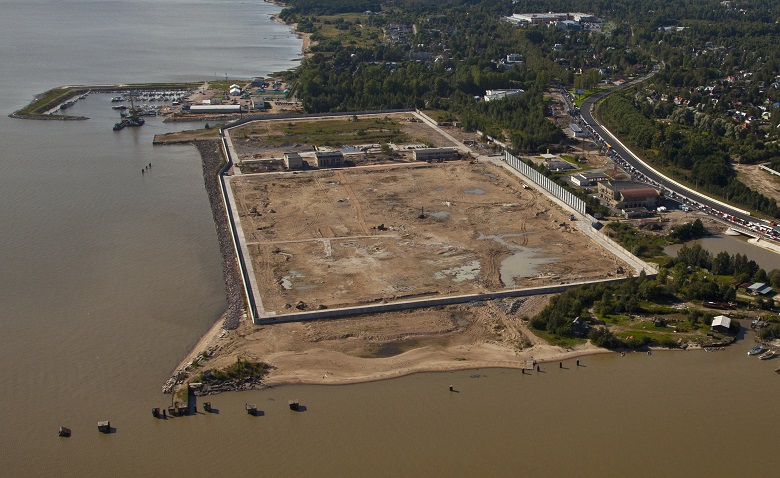
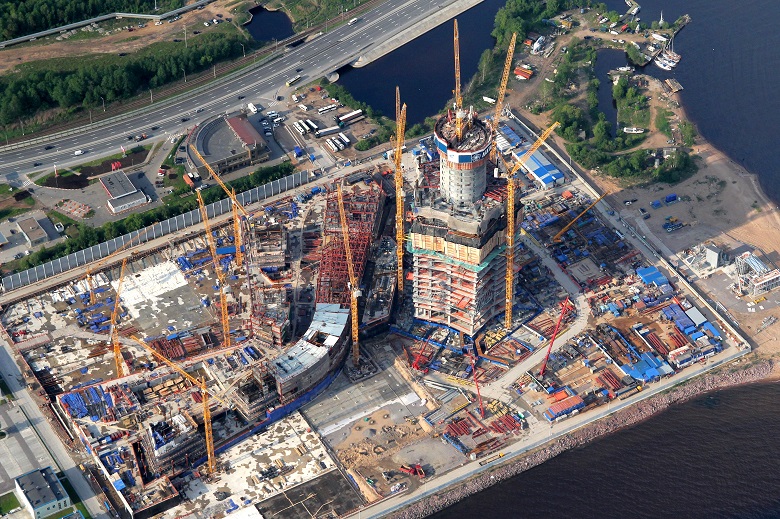
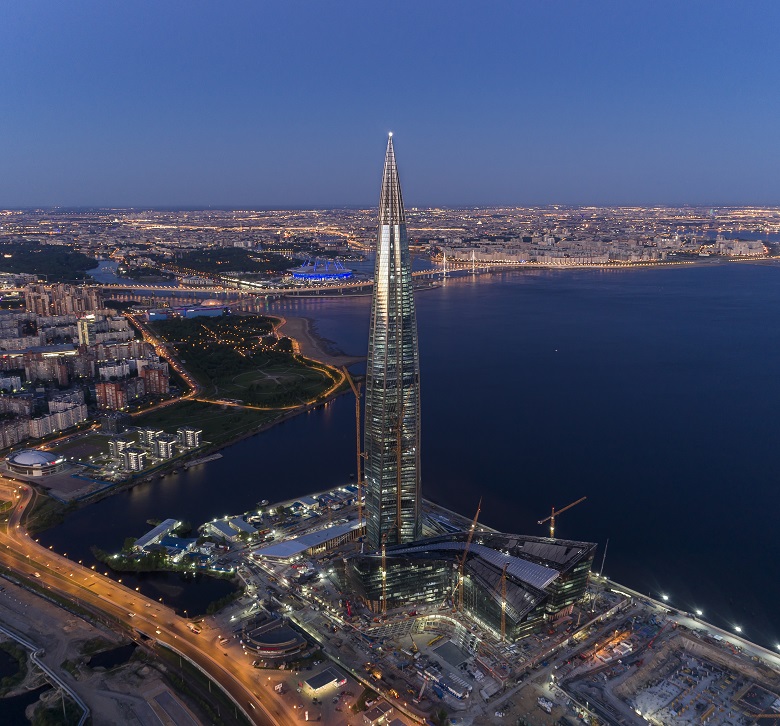
Changes in the construction landscape during the construction of the Lakhta Center complex, 2012-2018
Sometimes fire fighters, perhaps with the thought: “So we knew!”, Expressed a little less literary, go to a construction site. Fires in unfinished skyscrapers are not so rare. One of the closest examples to us is the state of emergency of 2012 in the Vostok tower under construction at the Federation business complex in Moscow City. Due to contact with the hot surface of the spotlight, the material covering the formwork caught fire. The fire occurred on the 67th floor and spread over an area of 300 m2. Put out in a few hours. Could have been faster, but, as it turned out, the construction fire-fighting conduit did not work. Thanks to the firefighters that there were no casualties and major damage to the building.
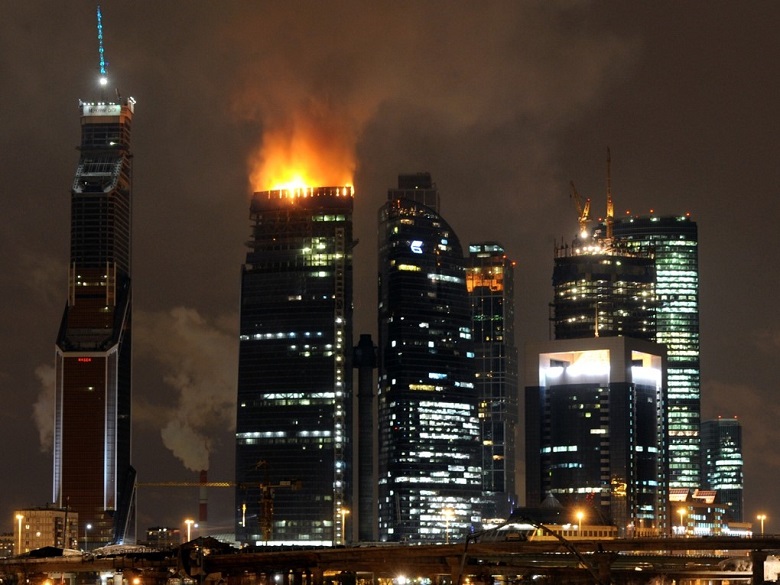
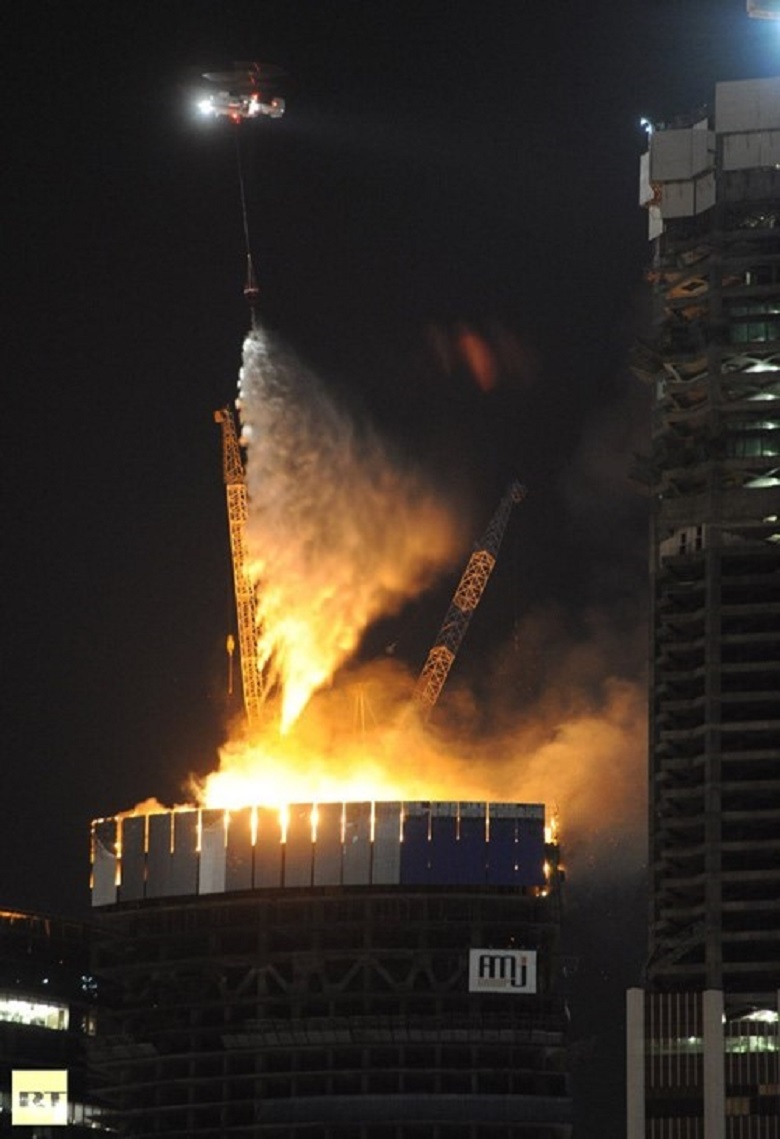
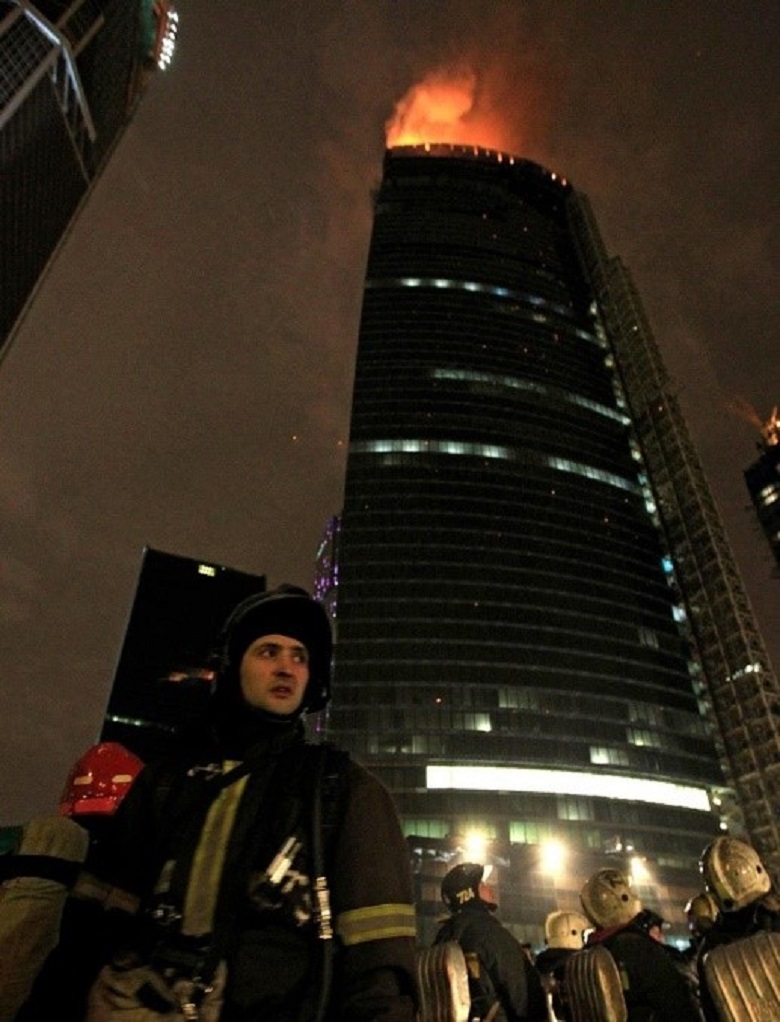
Much more serious is the event of 2013 in the constructed 145-meter Olympus tower of the Grozny-City complex. The installer used a gas burner to glue the joints of the soft roof and accidentally set fire to the material. Strong wind - the fire spread to the facade, covered with "plastic elements" and within half an hour embraced the building, as eyewitnesses reported .
The Grozny firefighters did not have equipment capable of reaching the desired floor; there is no information about the construction conduit. Emergencies Ministry aircraft only entered combat the next morning - wind, darkness and dense buildings prevented the aircraft from flying to the rescue immediately. There were no casualties. Firefighters completely evacuated not only Olympus, but also neighboring buildings.
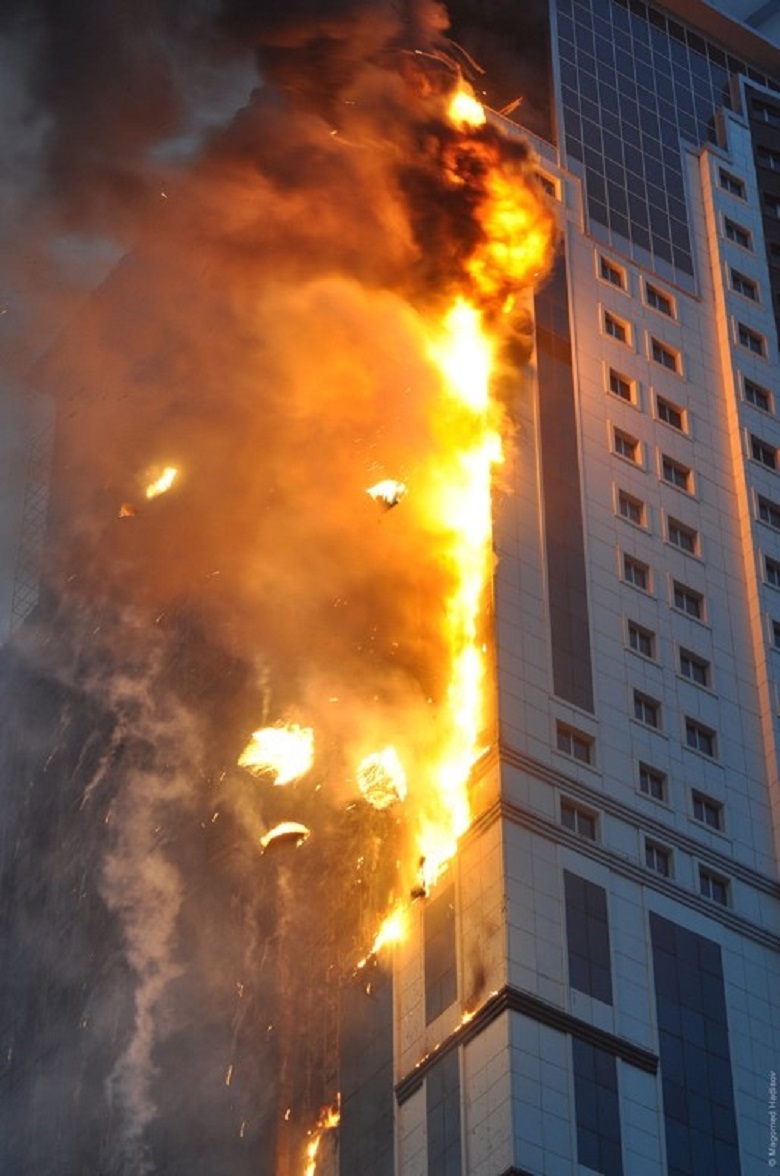
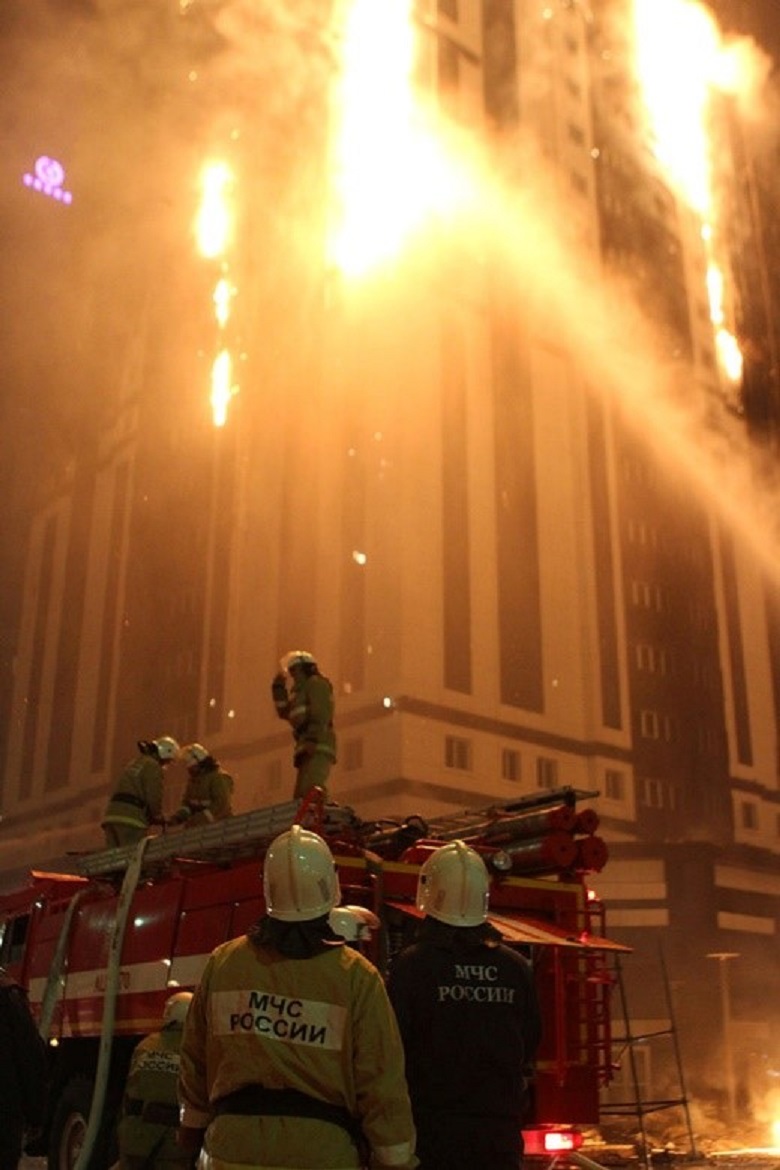
We admit - firefighters also came to our construction site. Here is how it was.
CHRONICLE OF VIRTUAL FIRES
November, 2016

Members of the Lakhta Online. Primorsky district ”discuss:
-“ It seems that it caught fire ”
-“ Yes, black smoke ”
-“ Vapers! ”
-“ Bob Marley's birthday is celebrated ”
March, 2017
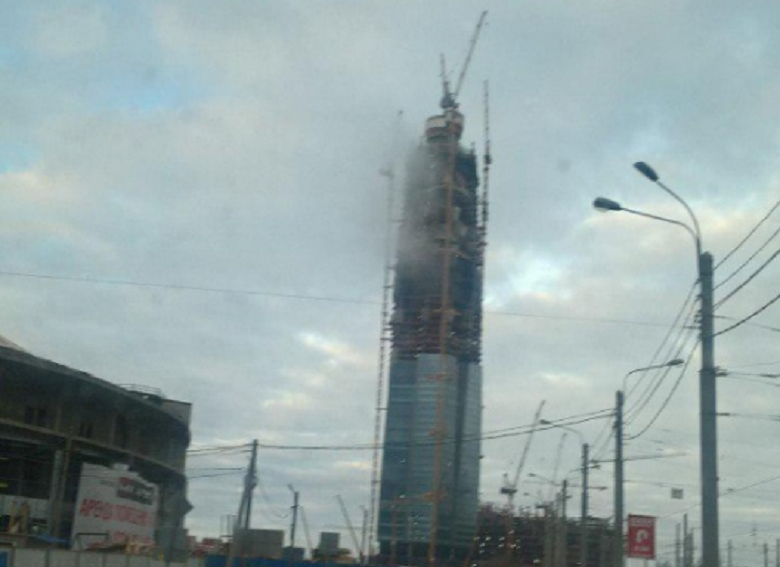
Nevsky Novosti: “Eyewitnesses stated that the Lakhta Center is smoking ... The upper third of the tower is shrouded in something that looks very much like smoke ... The circumstances of the fire are being specified.”
November 2017
There are two “fires” here at the beginning and at the end of the month.
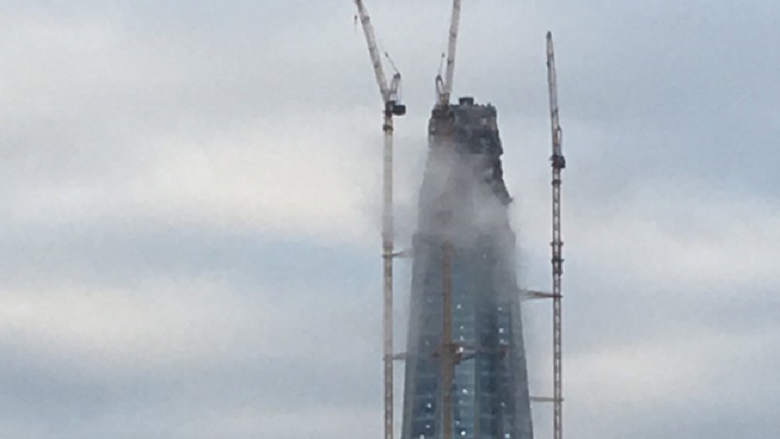
Social networks:
- “You can see the smoke and its more and more, and the smell is a little pungent at the height”
- “Our firemen are not ready for such a height!”
- “Why are they not ready?”
- “Do not smoke indoors!”
- “Eye Sauron begins to flare up ”
-“
They lit it instead of the Rostral columns ” -“ Here you look at skyscrapers in other countries, so they have special equipment in case of fire, and we have ..? ”
-“ And the thrust is good at altitude!) And fire safety to hell "
-" White smoke. Strange ”
-“ White smoke because the Pope was chosen ”
April 2018
Then the “fire” became almost a week - from April 6 to 10, users of social networks again shared a photo of the “flame-embraced” skyscraper.
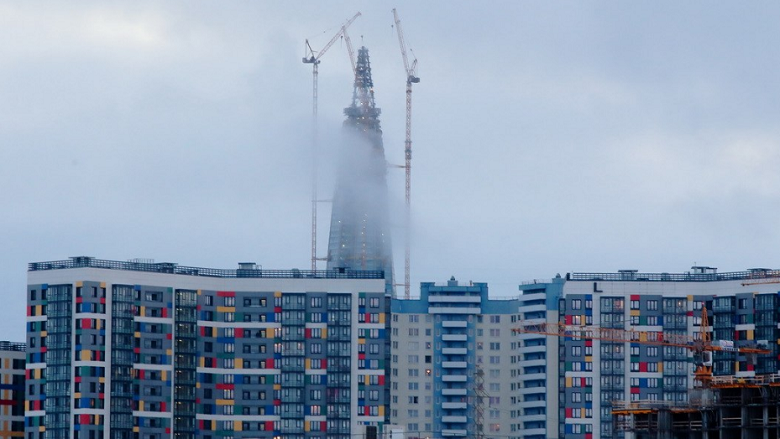

“Apocalypse in St. Petersburg!” - some publications write.
On the evening of April 6, Life opens a live broadcast of the “fire”, but “... by 20:45 there were no traces of“ smoke ”...”, the “Paper” notes.
The same photo, but in the author’s processing - the artistic effects in the form of colored smoke act as a poured oil into a virtual fire:

September 2018
Well, more recently:
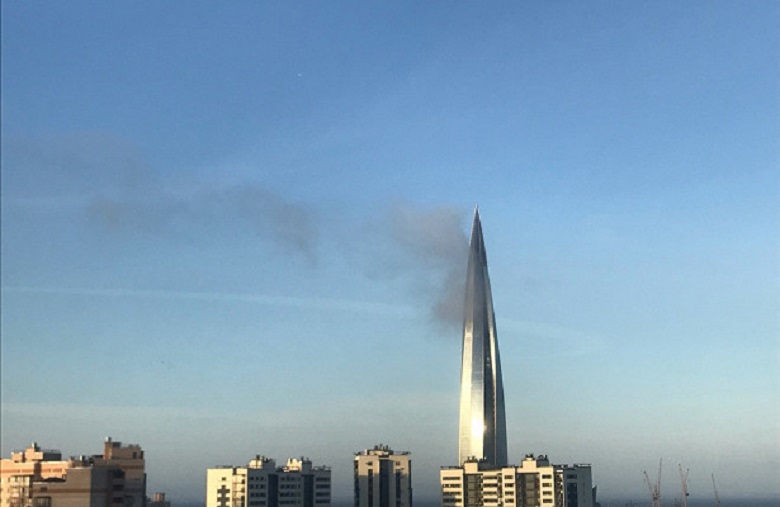
Photo 360 tv.ru
“Again does not burn” - journalists write. In social networks under posts with a “fire” instead of “First” in the comments: “Clouds!”
Someone always believes in a fire and calls the rescue service. Once, six fire brigades arrived at a construction site at once, then the Ministry of Emergencies officially explained that no fire could be found. The September visit, with five crews, was short - from 7:30 to 7:55. Firefighters again left with nothing - to mutual joy.
According to the chronicle, “fires” usually occur in spring and autumn, when certain atmospheric conditions are formed - temperature extremes, high humidity, low cloud cover. Sometimes low-flying torn clouds are to blame for the “sensation”, sometimes for increased vaporization from concrete work: as you know, concrete is very hot during pouring and hardening, while actively losing moisture. There are also clouds of dust from construction work, blown out by a gust of good seaside wind and morning condensation from the steel structures of the spire.
Since all concrete work is completed, and the contour of the buildings is closed, only cloud cover remains from the virtual fire triad. It’s autumn, it’s time to announce a competition for the best painted clouds in the area of the “upper third of the tower”.
As for the help of caring people calling the fire service - of course, we are grateful to them: the importance of timely calling of rescuers during an emergency cannot be overestimated. But specifically the case of Lakhta Center - you can see the real situation through a live camera . And we also have specialists who are responsible for the fire safety of the complex. These guys are not "Rock" Johnson, they are cooler. Many in the past - fire fighters, now they are doing everything - competently and clearly, in order to minimize the fire risks of the facility under construction.
I’ll tell you about the real fire below.
HOW THE FIRE SAFETY OF THE LAGHTA CENTER CONSTRUCTION IS PROVIDED
Water conduit - high and marine.
The height of the requirements for the fire safety system of skyscrapers is a match. The only problem is that at the construction stage these requirements and measures to ensure them do not work yet. Therefore, at the time of construction, temporary fire protection schemes are developed. Part of the decisions then becomes permanent. According to Russian standards, the “external fire water supply system of a building” - a water conduit, is created even before the start of construction.
Usually it connects to the city water supply network. For the Lakhta Center fire fighting system, the municipal resource was supplemented with a natural one: the complex is located on the shore of a fire reservoir quite suitable in size.

A special fire pier was built on the shores of the Gulf of Finland, connected to the construction site by dry pipes. Hydrants act as the main source of water, the additional - water from the bay.
A temporary fire line grew throughout the construction period along with the building. Its buildup overtook the core: fire safety in the first place.

The main postulate of the construction
Yes, and by the end of the construction we got one more “the most” - “the highest fire conduit in Europe”. Thanks to him, there is always water in the tower. On each floor there are four fire hydrants, which are powered according to a rather complex scheme.
The central pumping station is installed in the MFZ, which is able to pump water under the necessary pressure to the 17th floor of a skyscraper. There is an intermediate tank and another pump. There are five such intermediate stations in the skyscraper. They are located on the technical floors dividing the tower into fire compartments.
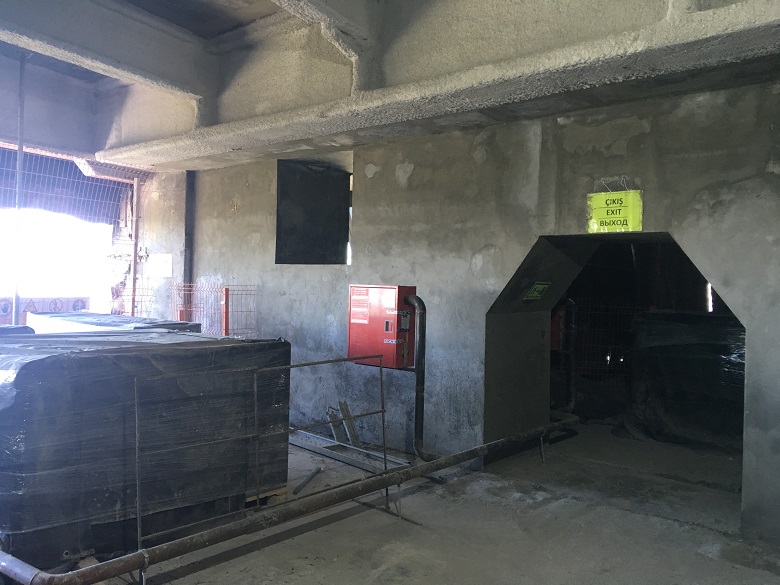
Fire crane on the technical floor of the Lakhta Center tower.

Fire hose stock
What to do with wooden structures?
Lakhta Center - a complex of steel, glass and concrete. From the point of view of firefighters, they are excellent, non-combustible materials. Not like plastic or wood. Although, stop. Wooden structures were used at the construction site, and played a central role.
Let's get back to basics. On the zero cycle, while the foundation pit is being built and the piles are clogged, there is nothing to be afraid of - there is nothing to burn. Another thing is pouring concrete structures, which began at the stage of creating the foundations, in the fall of 2014 for the Multipurpose building and in the winter and summer of 2015 for the Lakhta Center tower. Wooden formwork and all kinds of “greenhouses” burn and how. For example, as on the 100-meter pylon of the cable-stayed bridge of the WHSD in 2016.
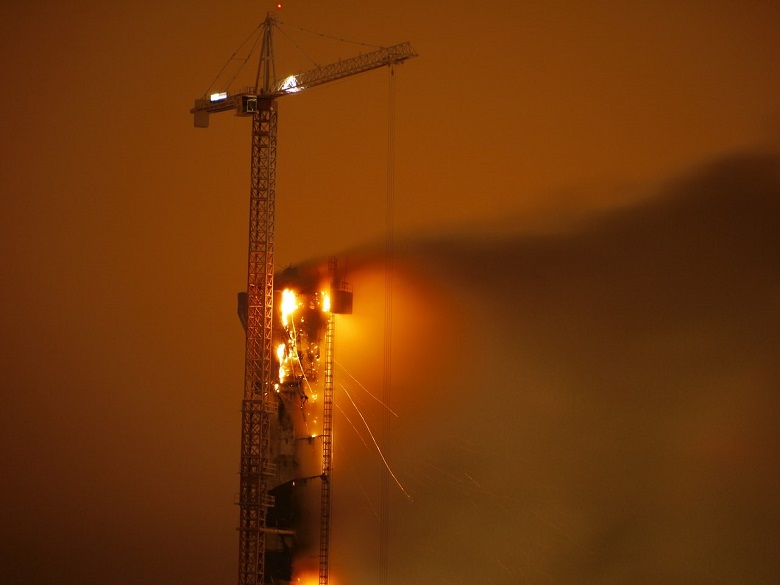
Therefore, the rules oblige high-rise builders to use non-combustible formwork and scaffolding. Which, alas, is too heavy. Because of this, the self-climbing four-level formwork used in the construction of the foundations and core of Lakhta Center was still wooden, but its use was enclosed in real armor from the conditions and rules.
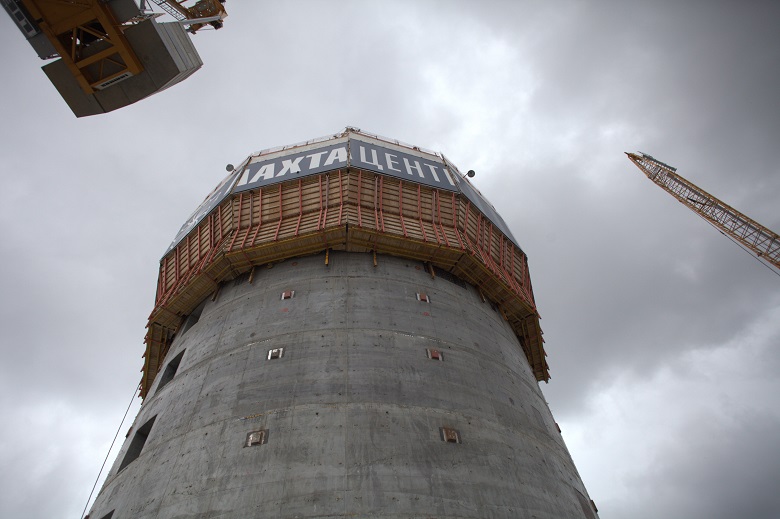
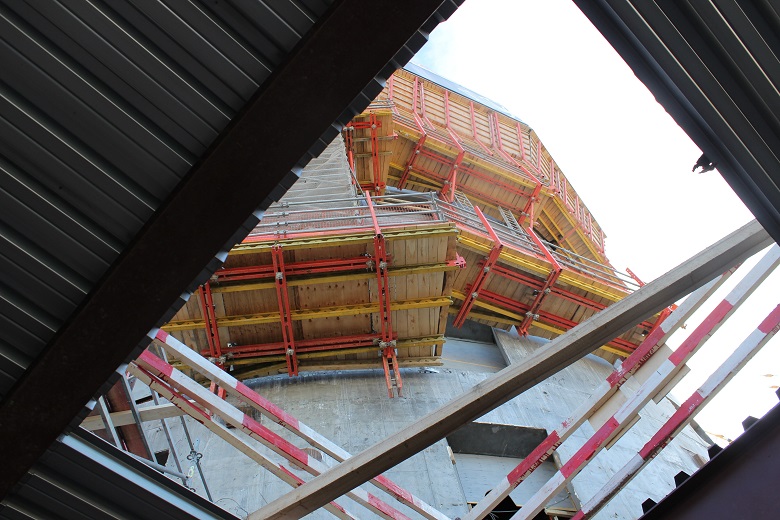

Self-moving formwork at the core of the Lakhta Center tower. It consists of steel crossbars and wooden elements, including flooring and thick laminated plywood - potential sources of trouble.
For the use of "combustible" devices, STUs were developed, which were approved by the regulatory council of the Main Directorate of the Ministry for Emergencies in St. Petersburg. The document prescribed the organization on the formwork of deluge fire extinguishing systems, fire alarms, emergency warning systems. All formwork designs were coated with flame retardants.
Fire and metal
Alexander Smirnov, fire safety engineer at the Department of Safety and Security at Lakhta Center:
- For the construction period, three STUs (special specifications) for our facility were issued regarding fire safety, which prescribed additional fire safety measures for the facility, as well as “burdening” of existing RF standards. This was done in view of the absence or incompleteness of regulatory documents on fire safety in the Russian Federation for buildings of such number of storeys.
In total, STU covered 20 points, not regulated in any way. Due to the inconsistency or lack of certain regulations regarding unique buildings, a single, but loud “fire” dispute arose around the construction site. It dealt with the timing of the processing of metal structures with flame retardants. "Immediately after the installation of structures," - during one of the visits inspectors insisted. In response, Rostekhnadzor ordered it to take into account the standards of the industrial SRO NOSTROY. And there, in black and white: after installation of engineering systems with elements of their fastening and reinforcement, completion of all welding operations, cleaning and priming of welds with anti-corrosion primer, and then on to points 5.2.1, 5.4.1, 5.4.3 and up to 5.4 .16, and also - clause 375 of the RF Prohibition. Question faded, not flaring up.
Of course, no one tried to “save” on fire retardant coatings for metal, as some observers suggested. The question is exclusively about the rules and conditions for applying fire protection - air temperatures are not lower than stable plus 3 and not in the open. The importance of fire protection itself is beyond doubt.
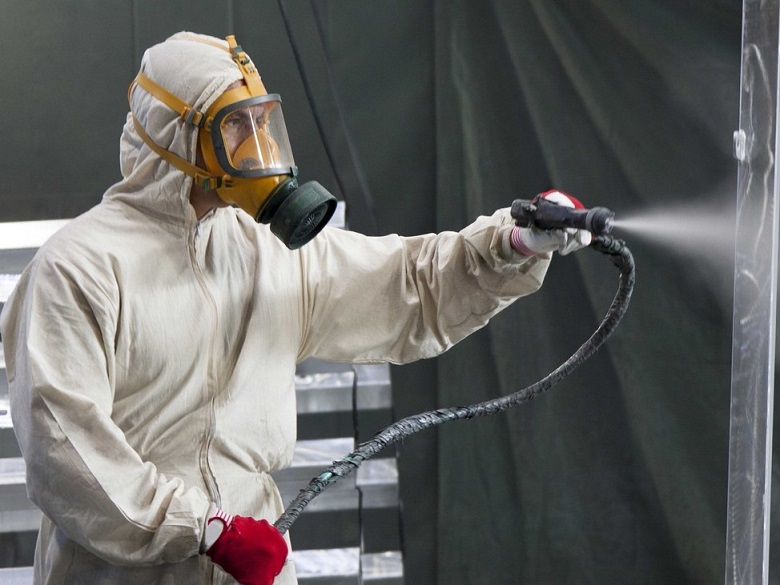
In the event of a fire, the load-bearing properties of metal beams not coated with flame retardants retain their characteristics for about 15 minutes, then deformation begins. After treatment with flame retardants, the time increases - up to several hours. In the event of an emergency, even the extra minutes can be saved lives. And the clock is an invaluable time to evacuate and fight the fire. Here, the case of the collapsing collapse of the New York “twins” was repeatedly discussed here, according to the conclusions of the investigation, caused by the fire and the rapid deformation of steel columns. Nobody even wants to remotely repeat such an experiment, so everything is used - fire retardants, and outrigger belts and safety zones in a reinforced concrete core that can withstand fire for 4 hours.
The load-bearing beams of the interfloor ceilings in the tower and MPF are treated with structural fire protection. Outwardly, it resembles a non-combustible fluffy stucco with extremely low thermal conductivity.
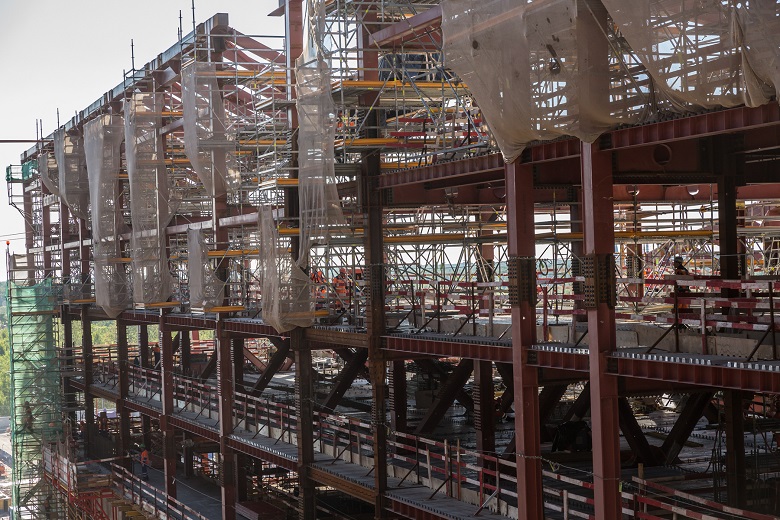

Beams of interfloor ceilings of the Multifunctional building before processing with fire-retardant composition.

Beginning of processing - there will be several covering layers, after which the beams become frosty.
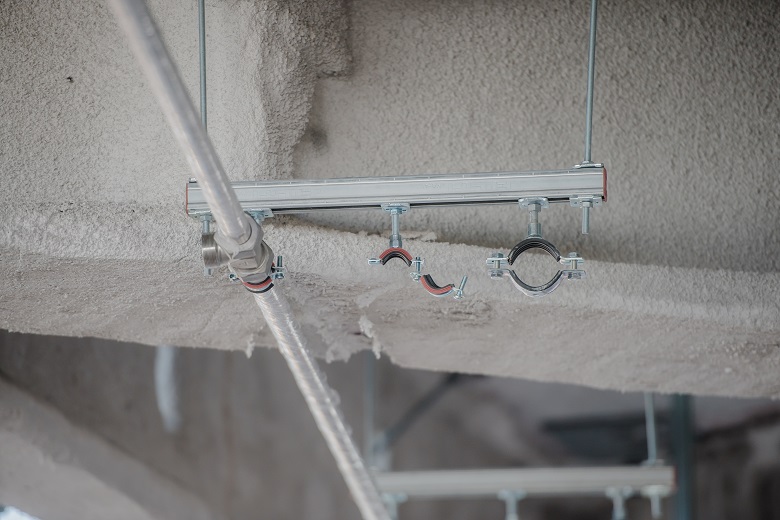
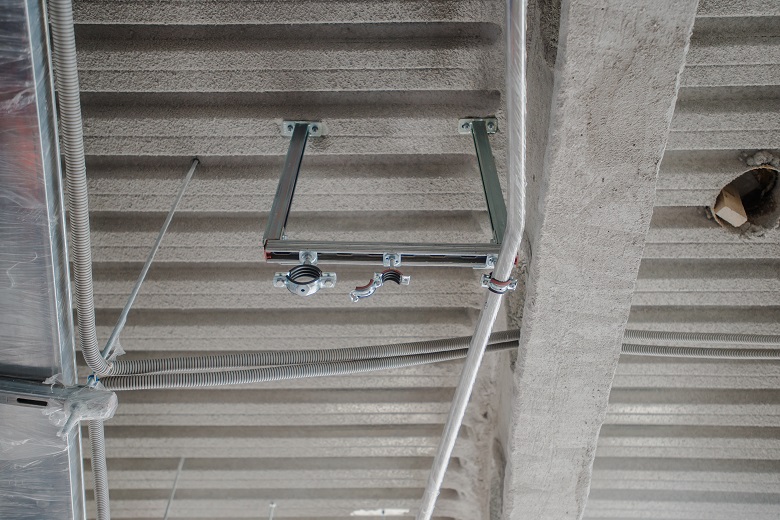
The processed interfloor floors of the tower, the composition is close.
Several layers of such “plaster” provide a fire resistance level of ceilings twice as high as the standard - at the level R 240 - 4 hours of fire without changing the properties of the metal and the geometry of the structures.
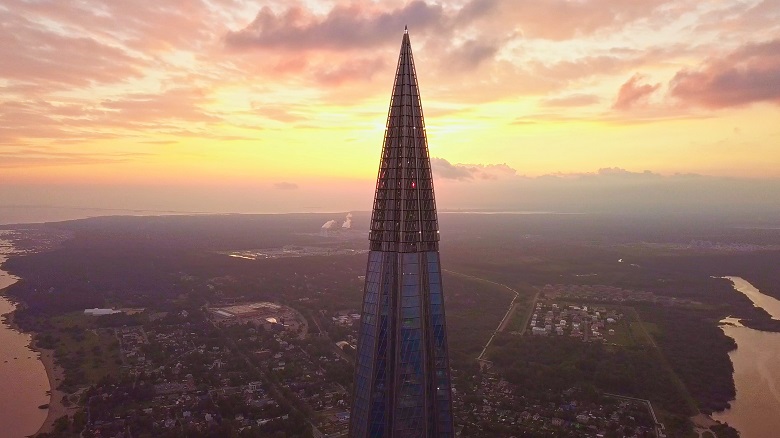
The metal structures of the spire are treated with a thin-layer structural fire protection, which is more suitable for outdoor conditions.
Fire brigade of the warning response The
fire brigade is nearby - Morskaya street, house 3.
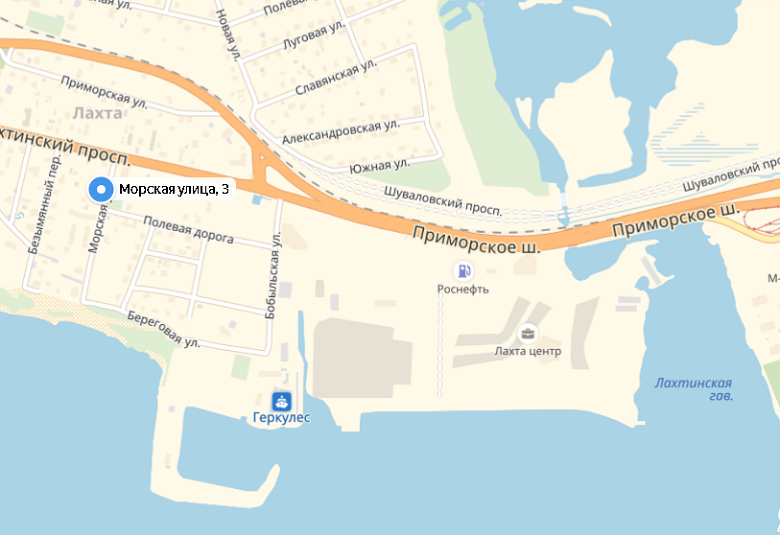
To arrive at the construction site, fire fighters need only 4 minutes. How to make sure that they do not come at all? Or - if an emergency did happen, how to use these 4 minutes with maximum benefit?
The answer is the presence of their fire fighting group, whose employees are on duty around the clock at the construction site. Their task is to ensure that every builder complies with all fire safety rules. Trite? Yes. But you need a truly unlucky combination of circumstances or a unique force majeure in order for a fire to happen when all the rules are met. The main cause of the incidents is a violation of what everyone knows. Yes, like not to carry out hot work near combustible materials. Not to mention the classics - not extinguished cigarette butts thrown into construction waste.
Alexander Gladilin, Leading Fire Engineer at Lakhta Center:
- The fire prevention service was created at the facility by the contractor, Renaissance Construction, from the moment it arrived at the facility and has been working 24/7 since then.
This is a separate unit, whose responsibilities include the search and suppression of violations, calling the fire department in the event of an emergency, and until the regular units arrive, the primary fire extinguishing, organization of evacuation, upon arrival of the fire department, meeting and escorting firefighters to the construction site to the place , which reduces the search time for the fire.
The quick fire response group includes more than 50 people, taking into account day and night shifts. Service employees can be distinguished by the standard method for builders - by helmets: they have a light green color.
Every day, these people look for weaknesses - they are present where welding and firing work is going on, they check the availability and serviceability of the "primary extinguishing means", alarm systems and voice warning systems - fire extinguishers, water pipes, information signs.

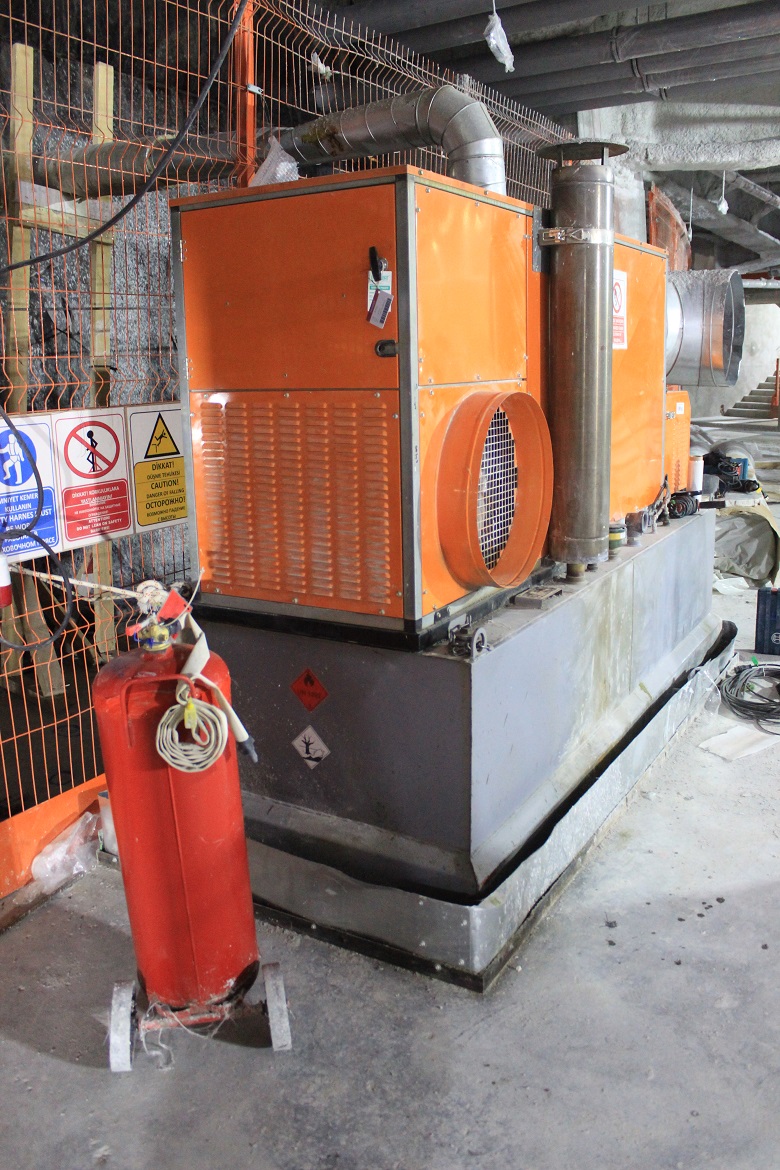

Primary extinguishing media and information signs at a construction site - everywhere. Standing at one - you see the next
Shovels and boxes of sand, fire extinguishers and instructions for their use at a construction site can be found everywhere, even in the most unexpected places. For example - here is a fire extinguisher on a mock site of the Lakhta Center.

It would seem, what to burn there? But the strength of the rules lies in their rigorous execution. It should be - there is nothing to talk about.
It does not burn where it is clean
At the construction site, the Lakhta Center has always been neat - as much as possible under construction conditions.

In 2013, "The Best Building Site and Hometown" was noted in the professional competition "Stroymaster". Interestingly, such accuracy is a characteristic of fire safety. Construction waste is a nice kindling. Therefore, each shift in construction ends the same way - the removal of industrial waste. This is a constant constant in a rapidly changing construction process.
Stroygorodok is an area of everyday life. And here - it is especially important not to relax. For example, special rooms are equipped here for drying shoes and clothes - otherwise people would be forced to do this on heating devices. Designated smoking area. No, there are no sites for barbecue - this is only outside the construction site.
Temporary office buildings and cabins construction site are protected by automatic fire alarms and modular powder fire extinguishing systems. Due to space saving, the objects are quite close to each other, therefore, in case of an emergency, water curtains will work between the buildings.
People
Have you noticed that the human factor is the main driving force of emergency and disasters? Events are superimposed on one another, but in 9 out of 10 cases, investigators say something like: “If this Skettino was following the course ...”. Yes, in our century of the fourth technological revolution, man is still the main force majeure and the main character.
Alexander Smirnov, fire safety engineer at Lakhta Center:
- All of these numerous and rather complex technical systems protect the construction site from fire, probably by 10 percent. The remaining 90% are carried by people who are involved in fire prevention. Indeed, almost always the cause of the fire is the human factor. This is an everyday chore that seems to be invisible to no one, but believe me, there are a lot of it.
The “human factor” is fought with punishment and enlightenment. The punishment for violators of the fire safety rules at the Lakhta Center construction site is dismissal.
As for enlightenment, it is put on a wide rails. Everyone is instructed in accordance with safety regulations, and once a month, builders receive fire drills.
Trained to evacuate. When asked to tell us about the teachings, our firefighters dismissed - they say, this is standard work.
Alexander Gladilin, Leading Fire Engineer at Lakhta Center:
“Everything is as always and everywhere: the alarm sounds, people stop working, go out, gather in specially designated areas, responsible persons check the availability of personnel. This is a routine, but a routine is very important. And, I can say with satisfaction that there was not a single case where someone did not have time to leave the danger zone until, according to one scenario or another, the main escape routes were blocked by dangerous fire factors. ”
Or here:
Александр Смирнов, инженер по пожарной безопасности отдела ОТ и ПБ Лахта Центра:
«Сценарии учений? В сценарии нет ничего интересного для статьи, это не те красивые учения которые показывают по телевизору, у нас никого героически не спасают! В наших учениях отрабатывается эвакуация рабочих из здания и взаимодействие служб объекта, электрики, сотрудники ППГ, лифтеры, начальники строительных участков, крановщики, ответственные лица, все должны знать свои задачи при поступлении сигнала о пожаре — кому звонить, что отключать, куда эвакуироваться, кому отчитываться о количестве эвакуированных людей, как встретить прибывающие пожарные машины и т.д. и т.п»
Well, no, we already saw about the heroic salvation - in a previous post . A properly organized routine is what really matters. Here are some photos from the March 2016 exercises. Then, according to the scenario, the formwork on the 17th floor of the tower “burned”, the situation was complicated by the presence of the “wounded”.

The tower crane is one of the "large Ka", it takes the cradle with the "victim".
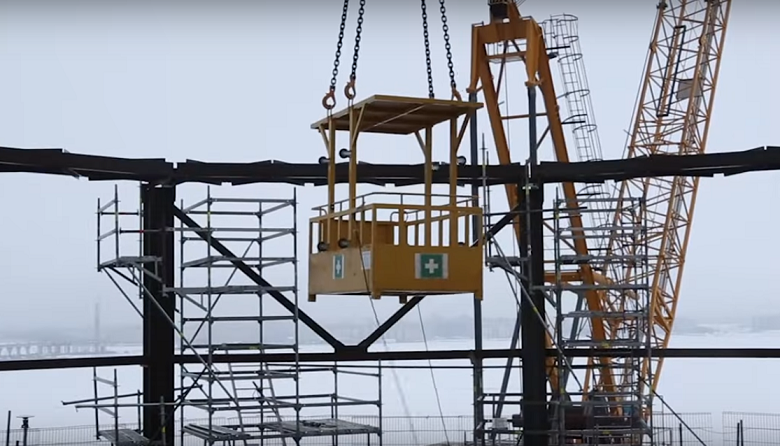

And carefully evacuates her from floor to ground.
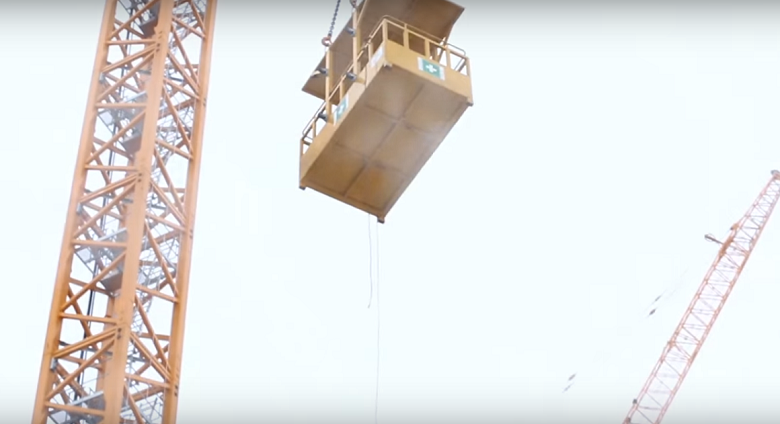
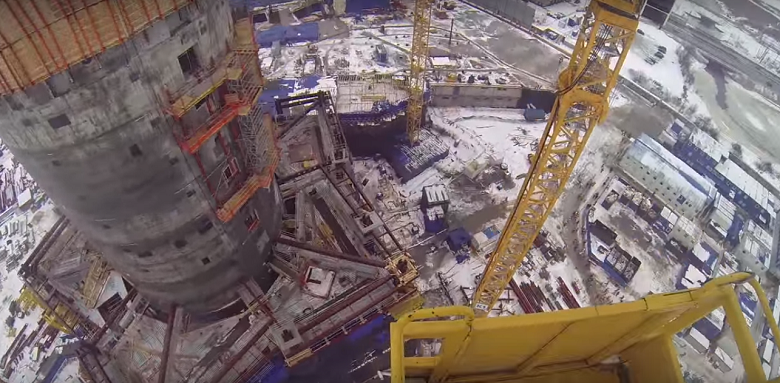
A good view is opened from the cradle - but the “victim” does not have the opportunity to evaluate it: it's just a dummy.
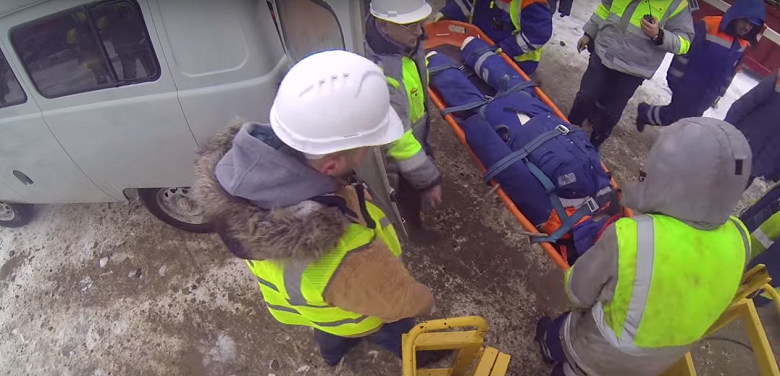
The “injured” is sent on a stretcher to the ambulance. And this is evacuation from the “dangerous” and the highest floor - at the time of shooting in 2016, it was then that seemed very high 17th. Here, according to the legend of the exercises, the formwork “burns”.
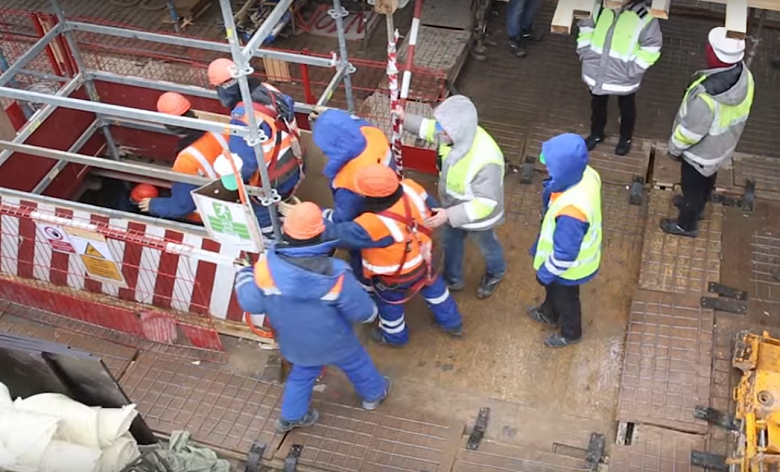
Captains, that is, engineers, leave the floor last after the rank and file workers and foremen leave.
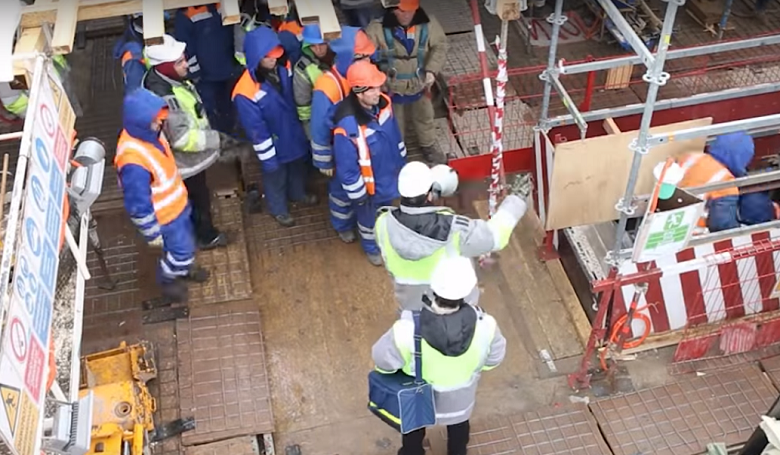
Estimated time of access to the evacuation ladder - 45 seconds, leaving the floor - within 2 minutes. The technician responsible for the evacuation regulates the process using commands given through the loudspeaker. After evacuation - debriefing.
Such exercises were carried out both in daylight and in the dark. The need for fairly frequent simulations is related to the fact that the tower was constantly growing, evacuation routes were changing, and people needed to learn a new road with their feet.
It was with the exercises, and not with the clouds, that the first cases of concern of observers regarding a fire at a construction site were associated. The sound of a training fire siren spreading around the area for the first time scared the locals in earnest - they called the construction site and made sure that everything was in order.
And if it lights up?
Then - everything as practiced. People will leave the escape stairs and leave the building.

One of the two evacuation stairs in the core of the tower.
For the evacuation of builders, all exits to the stairwells are equipped with fireproof doors.
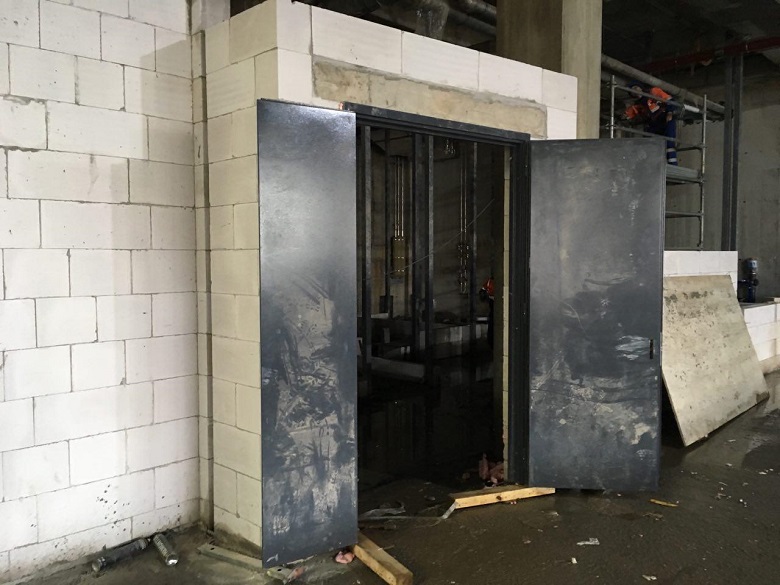
Doors are temporary, and such a luxury is unlikely to be found on any other construction site - quite an expensive pleasure. But in the unfinished, with this glazed building, smoke has nowhere to go except for the stairs, and the air supports of the escape routes have not yet been included. It means that a reliable barrier must be created between the rescuing people and the fire. Installed for the safety of builders, temporary fire-resistant doors can restrain the spread of fire and smoke for about 30 minutes - enough to leave the fire compartment.
What is special about the fire protection of the Lakhta Center construction site?
Probably nothing. Except that everything is according to the rules that are followed. Already an almost unique situation.
Александр Смирнов, инженер по пожарной безопасности отдела ОТ и ПБ Лахта Центра:
— Я бы сказал, что все на объекте сделано в плане пожарной безопасности так, как должно быть! Просто не на всех объектах строительства это выполнено в полной мере… Например часто вы на строительном объекте можете встретить временную пожарную сигнализацию, временную систему оповещения о пожаре, временный полноценный противопожарный водопровод на всех этажах здания, включая только что залитое перекрытие, есть даже в определенных местах временное модульное порошковое пожаротушение? Мне кажется, что нет! А у нас есть)
***
Firefighters are probably a bit superstitious. They will not be praised by the fact that for the entire elapsed period of the rack there has not been a single fire. But he was not there. And this is an achievement - not noticeable to outsiders, but so important. Superhero.
I promised to tell you about a real fire?
Here it is - such crimson, burning sunsets were over the Lakhta Center construction site in July this year. Just a fire!
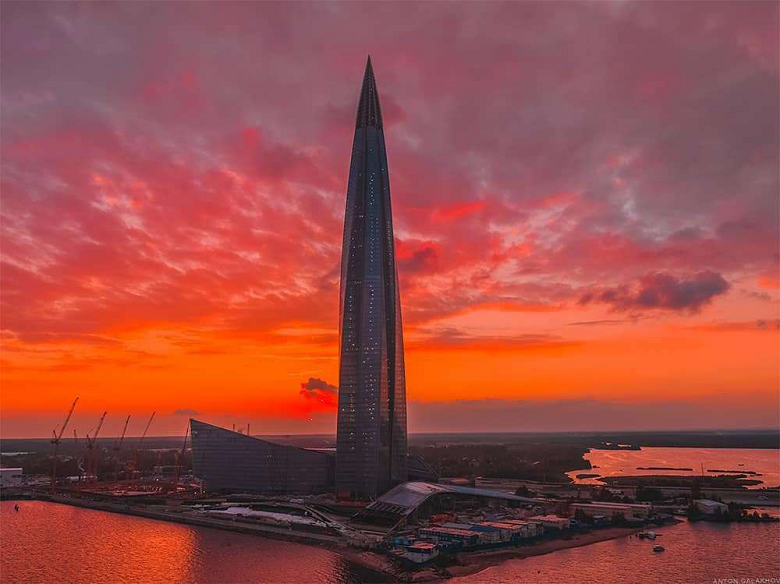
Photo - Anton Galakhov
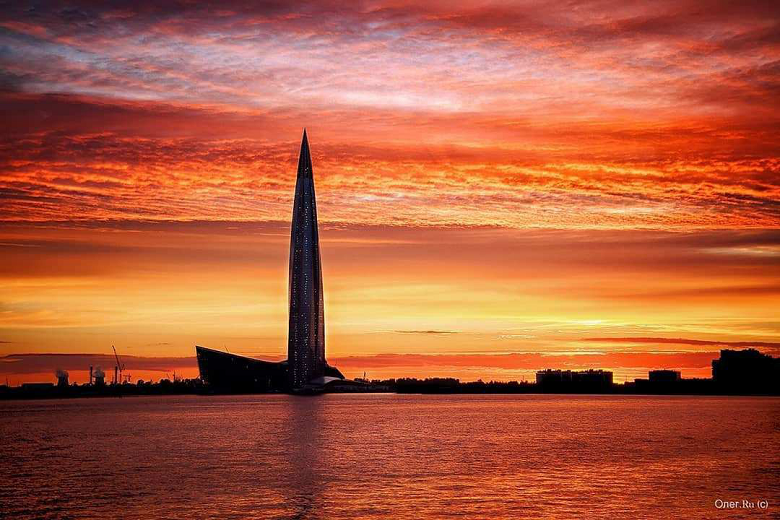
Photo by Oleg Rudin
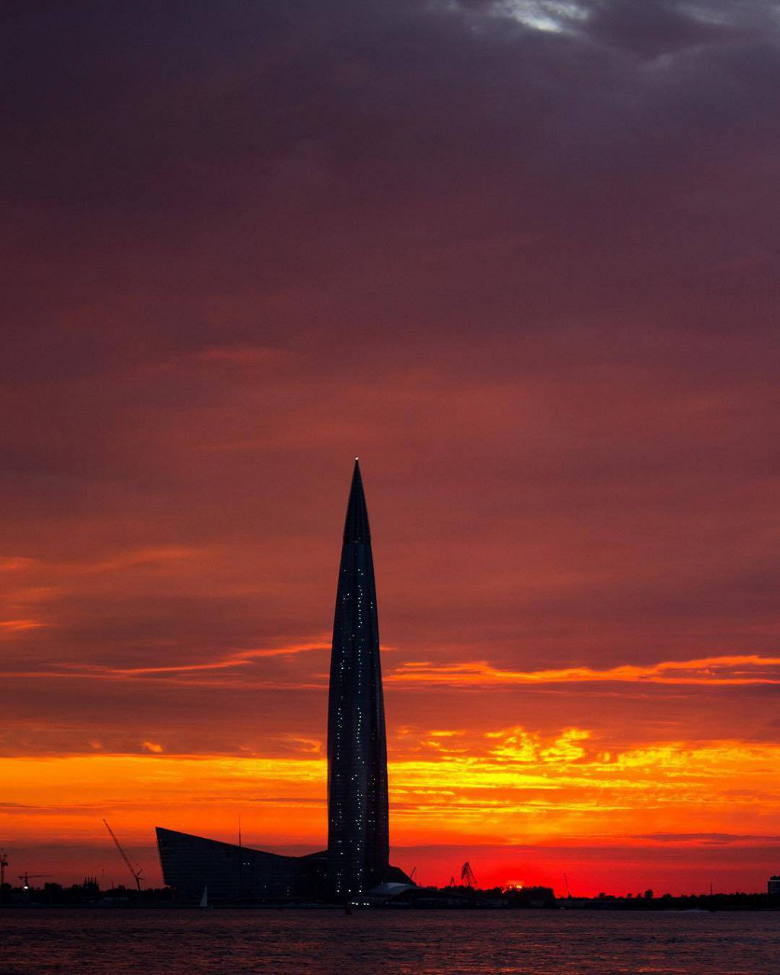
Photo - Mikhail
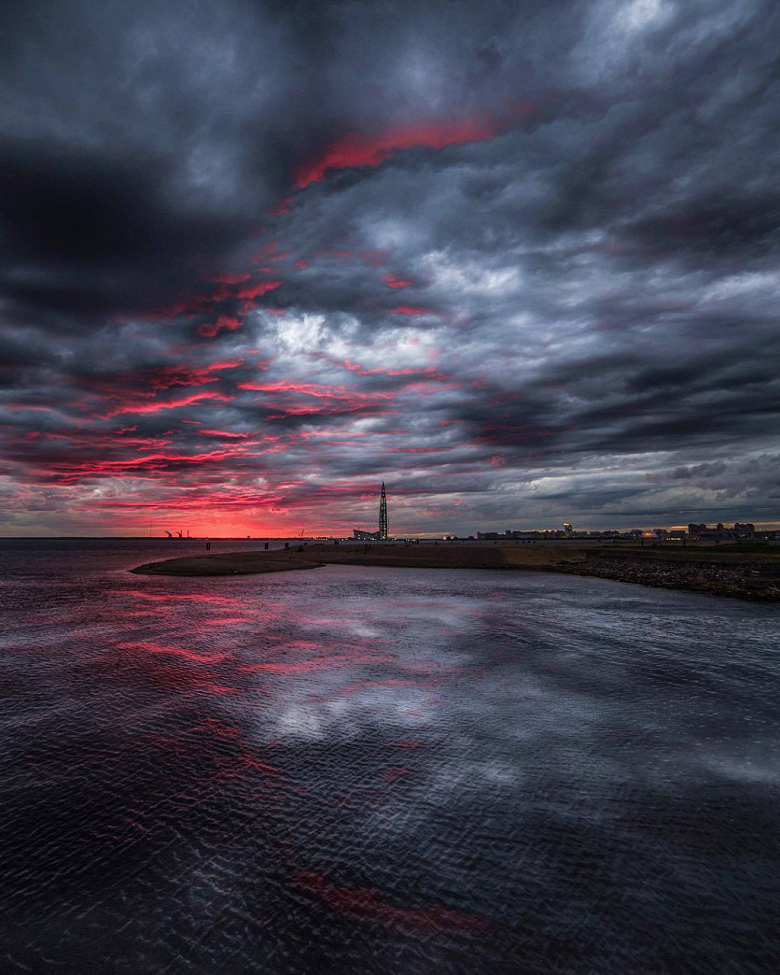
Photo - angelshula
Well-known sports commentator Tancredi Palmeri signed his photo “St. Petersburg is on fire”, “... burning sky where you want to disappear in”:

These are the only correct fires. I wish everyone to encounter only such.
***
About how the Lakhta Center will be protected from fire during operation, read the second part of the review. We will talk about how to evacuate 8 thousand people from a skyscraper, to what temperature in a fire the facade glass can warm up, which is common between a high-rise building and an oil tanker. There are also answers to readers' questions: how to evacuate if a fire occurs on the ground floor and the ethics of leaving the building in a fire - a comment on an excerpt from the book “Crises and disasters. Who and why survives. "
***
Thanks for the help in preparing the material, thanks to Alexander Gladilin - leading engineer for fire systems, Alexander Smirnov - fire safety engineer of the OT and PB department, Pavel Vinokurov - head of the construction control department, Alexey Sivokho and Igor Romanenko - construction control engineers of the Lakhta Center
